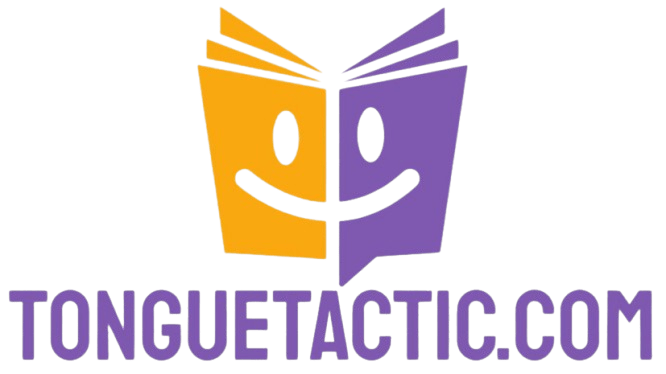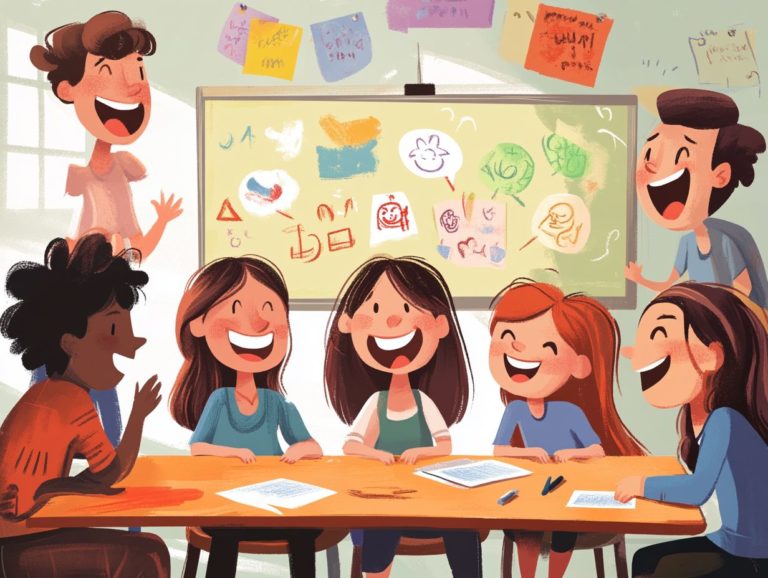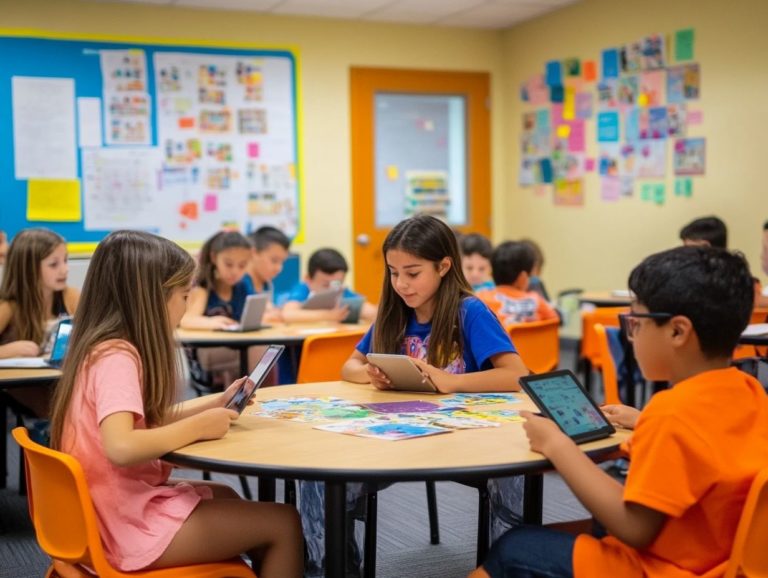10 creative writing exercises for language learners
Creative writing isn’t reserved solely for seasoned authors; it’s a remarkable tool for language learners like you.
This article delves into ten engaging writing exercises crafted to ignite your imagination while enhancing your language skills. From describing everyday objects to crafting short stories with unique constraints, these activities encourage your creative thinking and self-expression in fresh and exciting ways.
You’ll also discover the benefits of creative writing for language acquisition and gain tips on seamlessly integrating it into your study routines. Get ready to unleash your creativity now and elevate your language journey!
Contents
- Key Takeaways:
- 1. Describe an Everyday Object in Detail
- 2. Write a Short Story Using Only Dialogue
- 3. Create a Character Based on a Randomly Selected Image
- 4. Write a Poem Using Only Nouns
- 5. Rewrite a Famous Fairy Tale in a Modern Setting
- 6. Write a Letter to Your Future Self
- 7. Describe a Place You Have Never Been to Before
- 8. Write a Short Story Using Only One-Syllable Words
- 9. Create a Dialogue Between Two Inanimate Objects
- 10. Write a Story Based on a Randomly Generated Title
- How Can Creative Writing Help Language Learners?
- What Are the Benefits of Using Creative Writing Exercises?
- How Can Creative Writing Help Improve Language Skills?
- What Are Some Other Creative Writing Exercises for Language Learners?
- How Can Language Learners Incorporate Creative Writing into Their Study Routine?
- What Are Some Tips for Overcoming Writer’s Block in Language Learning?
- Frequently Asked Questions
- What are some examples of creative writing exercises for language learners?
- How can these exercises help language learners improve their writing skills?
- Can these exercises be adapted for different levels of language learners?
- How often should these exercises be used in language learning?
- Do these exercises only focus on writing or can they also help with other language skills?
- Are there any resources or materials needed to implement these exercises?
Key Takeaways:

Creative writing improves language skills and helps overcome writer’s block. Try fun exercises like describing objects or creating characters to practice grammar and vocabulary.
1. Describe an Everyday Object in Detail
Describing an everyday object in detail elevates your English as a Second Language (ESL) writing and fosters vocabulary expansion and effective communication. This enables you to express your ideas clearly through various writing exercises and practice.
Take the common pen, for instance. This unassuming tool, often dressed in an array of colors, designs, and grips, invites you to explore its texture and the sensations it evokes as your fingers wrap around it.
Think about how a writing task could ask you to reflect on the pen’s significance in your life perhaps as a loyal companion during those late-night study marathons or as an instrument for capturing fleeting ideas that dance through your mind.
Objects like a cherished mug, a pair of well-loved shoes, or an old photograph can serve as profound sources of inspiration. By diving into the stories behind these items, you foster personal connections that enhance your storytelling skills and ultimately improve your expressive abilities.
2. Write a Short Story Using Only Dialogue
Writing a short story using only dialogue is a challenge that can significantly enhance your narrative skills and creative writing techniques. It pushes you to convey emotions and actions without leaning on descriptive text.
This method helps you create real conversations while encouraging you to think critically about the weight of each spoken word. For instance, prompts like:
- Two friends at a coffee shop discussing their dreams
- An argument between siblings over a forgotten birthday
can ignite dynamic interactions.
To further engage your learning experience, consider participating in role-playing activities where you and your classmates improvise based on these prompts. This approach fosters teamwork and collaboration. Peer reviews are highly beneficial, allowing you to provide constructive feedback on each other’s dialogue-driven stories, ultimately refining your skills and boosting your confidence in writing.
3. Create a Character Based on a Randomly Selected Image
Pick a random image to inspire your character creation, encouraging you to develop unique personalities and backstories that resonate with your own experiences and perspectives.
This process sharpens your descriptive skills and invites you to explore your characters’ motivations and dilemmas on a deeper level.
To kick things off, take a good look at the chosen image, paying attention to details like facial expressions, clothing, and surroundings these elements can inspire rich facets of your character s life.
Building a character outline is crucial; incorporate aspects such as strengths, weaknesses, and aspirations. Personal reflection is key here; think about how your own experiences may shape these characters.
Engaging in writing assignments, such as crafting diary entries or letters from your character s viewpoint, can draw you further into your character s journey, enriching your understanding of the narrative you’re weaving.
4. Write a Poem Using Only Nouns
Writing a poem using only nouns invites you to focus on vocabulary building while enhancing your written expression through creative techniques. This approach results in content that is both engaging and thought-provoking.
By stripping away verbs and adjectives, you can concentrate on the core essence of nouns. This allows you to delve into imagery and concrete concepts.
This unique structure paves the way for creating vivid snapshots that can evoke emotions and spark contemplation.
For example, imagine a classroom activity where you brainstorm a list of nouns related to a theme like nature. You can select your favorites to craft a poem that reflects your personal perspective.
Peer reviews provide valuable feedback, fostering a supportive environment for artistic growth. Such methods refine your poetic skills while nurturing collaboration and creativity.
So, dive into your imagination and unleash your creativity today!
5. Rewrite a Famous Fairy Tale in a Modern Setting
Rewriting a beloved fairy tale in a modern context gives you the perfect opportunity to flex your creative writing muscles while deepening your cultural awareness and narrative skills.
By weaving contemporary themes into these timeless narratives, you can delve into important issues like technology, diversity, and social justice.
This encourages you to consider how characters might navigate the complexities of today s world, setting the stage for engaging discussions and critical thinking.
Have you ever wondered how Cinderella would cope with the pressures of social media? Imagine reimagining the Seven Dwarfs as a diverse group of friends or envisioning a modern spin on Little Red Riding Hood. These can serve as exciting springboards for your imagination.
This approach sparks creativity and allows you to connect with these stories on a much deeper level.
6. Write a Letter to Your Future Self
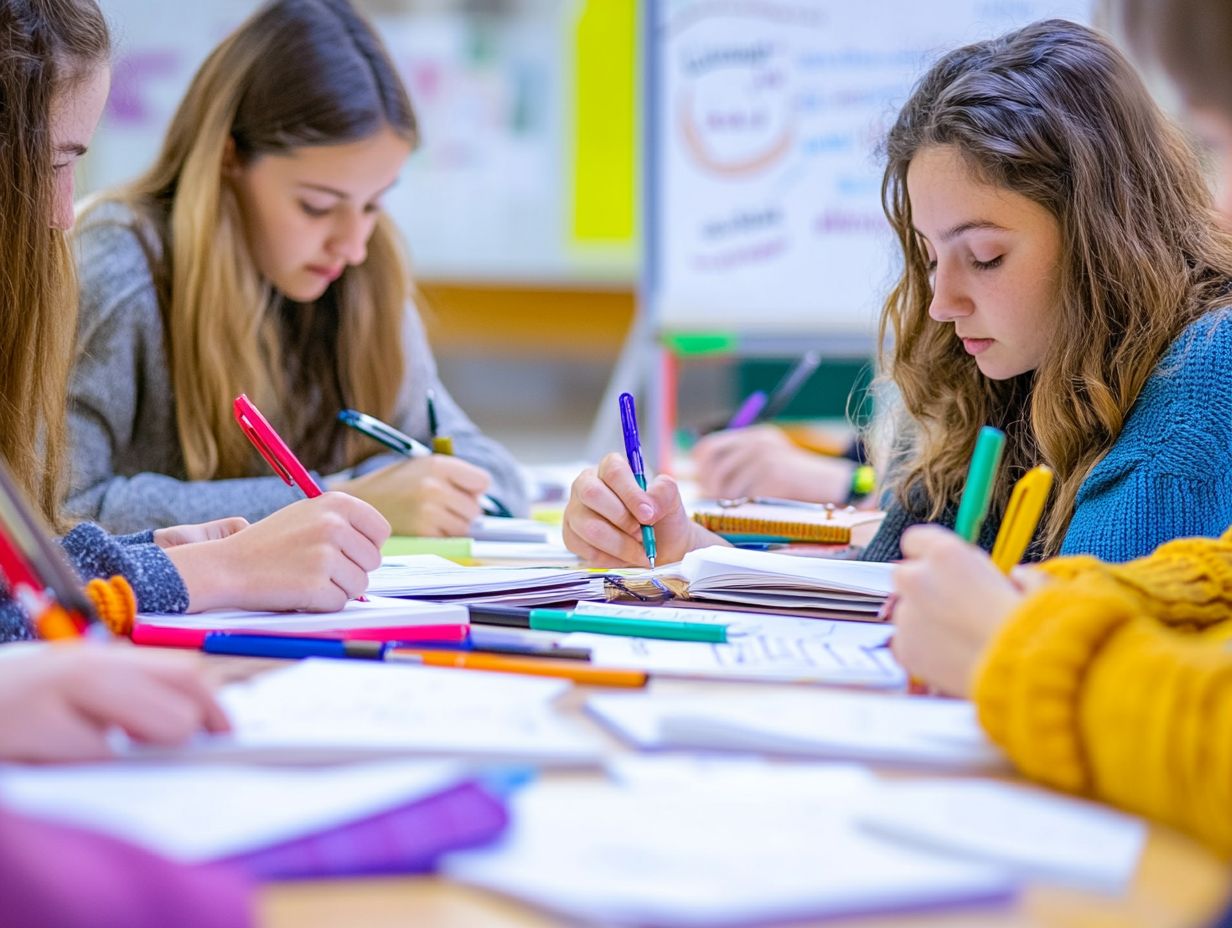
Writing a letter to your future self engages you in personal reflection, elevating both your writing practice and communication skills through a thoughtful expression of your goals and aspirations.
As you compose your letter, delve into your emotions and beliefs. This helps you gain a deeper understanding of your identity and dreams.
This exercise not only reinforces the structure and coherence of your writing but also opens the door to introspection.
Consider prompts like your proudest achievements or challenges you’ve overcome.
These reflective writing exercises create a rich dialogue between your present and future, ultimately nurturing a sense of purpose and commitment to your personal growth.
7. Describe a Place You Have Never Been to Before
Describing a place you ve never visited opens the door to a world of imagination, allowing you to build your vocabulary and deepen your cultural understanding through creative writing and vivid descriptions.
As you envision vibrant marketplaces alive with the aromas of exotic spices or serene beaches kissed by azure waves, you engage your senses and cultivate a richer connection to the world around you.
This creative exercise encourages you to explore diverse locations, experimenting with words that capture not just the sights, but also the sounds, tastes, and textures of each setting.
- Depict the hustle and bustle of a city square during a lively festival.
- Or describe the tranquil beauty of a secluded forest glen.
These scenarios can ignite your creativity and invite personal reflections, enabling you to weave your own experiences or aspirations into your narratives.
Try these exercises today and watch your writing skills flourish!
8. Write a Short Story Using Only One-Syllable Words
Writing a short story using only one-syllable words presents a unique challenge. It sharpens your writing skills and enhances your narrative abilities.
This exercise pushes you to think critically about your word choices. It reveals how each term can shift tone and meaning.
For instance, choosing “run” instead of “jog” can inject urgency into a scene. Meanwhile, opting for “see” over “gaze” might alter the emotional depth of a moment.
To dive deeper, you can also try rewriting a well-known fable using only one-syllable words. This allows you to witness how the narrative transforms.
You can also try activities like prompt challenges, where you craft dialogue or descriptive passages limited to one syllable. This approach fosters creativity within constraints and ignites a deeper engagement with the nuances of language.
9. Create a Dialogue Between Two Inanimate Objects
Creating a dialogue between two inanimate objects invites you to explore imaginative scenarios. It fosters creativity and engagement as you develop your writing skills through playful and humorous exchanges.
Imagine the lively banter between a lonely pencil and a cheerful eraser; this could lead to some unforgettable stories!
Integrating activities like group brainstorming sessions or peer review rounds can supercharge your creative process. Collaborating in small teams to craft and present your dialogues sharpens your communication skills.
As participants, you can offer constructive feedback to one another. This refines ideas and elevates your stories.
These interactive exercises spark enthusiasm and deepen understanding, transforming the writing process into a delightful collective adventure.
10. Write a Story Based on a Randomly Generated Title
Writing a story based on a randomly generated title can be a thrilling exercise for you as an ESL student. It sparks your imagination and pushes you to craft unique narratives while honing your writing skills.
This method encourages you to think beyond the usual confines. It invites you to explore diverse themes, formats, and character arcs.
By venturing into unexpected directions, you can break free from conventional storytelling tropes and discover your distinctive voice.
Sharing your narratives with classmates fosters a collaborative learning environment. This is where you can receive constructive feedback.
This exchange of ideas not only sparks further inspiration but also allows you to refine your craft. It builds confidence in your abilities, ultimately deepening your engagement with the writing process.
How Can Creative Writing Help Language Learners?
Creative writing is a powerful asset for you as a language learner, especially if you’re an ESL student. It enhances your writing skills, boosts engagement, and promotes effective communication through imaginative expression and structured practice.
This approach allows you to explore new vocabulary in context. It enables you to naturally acquire synonyms and expressions used by native speakers.
For example, when you’re prompted to write short stories using a specific list of words, you reinforce your understanding and unleash your creativity.
Grammar practice becomes a seamless part of the process. You craft sentences that demand attention to structure and punctuation.
Participating in peer-review activities can significantly enhance your narrative skills. By critiquing and refining each other’s work, you gain insights into various writing styles and perspectives.
This collaborative effort fosters a sense of community and shared learning. It ultimately elevates your overall language proficiency.
What Are the Benefits of Using Creative Writing Exercises?
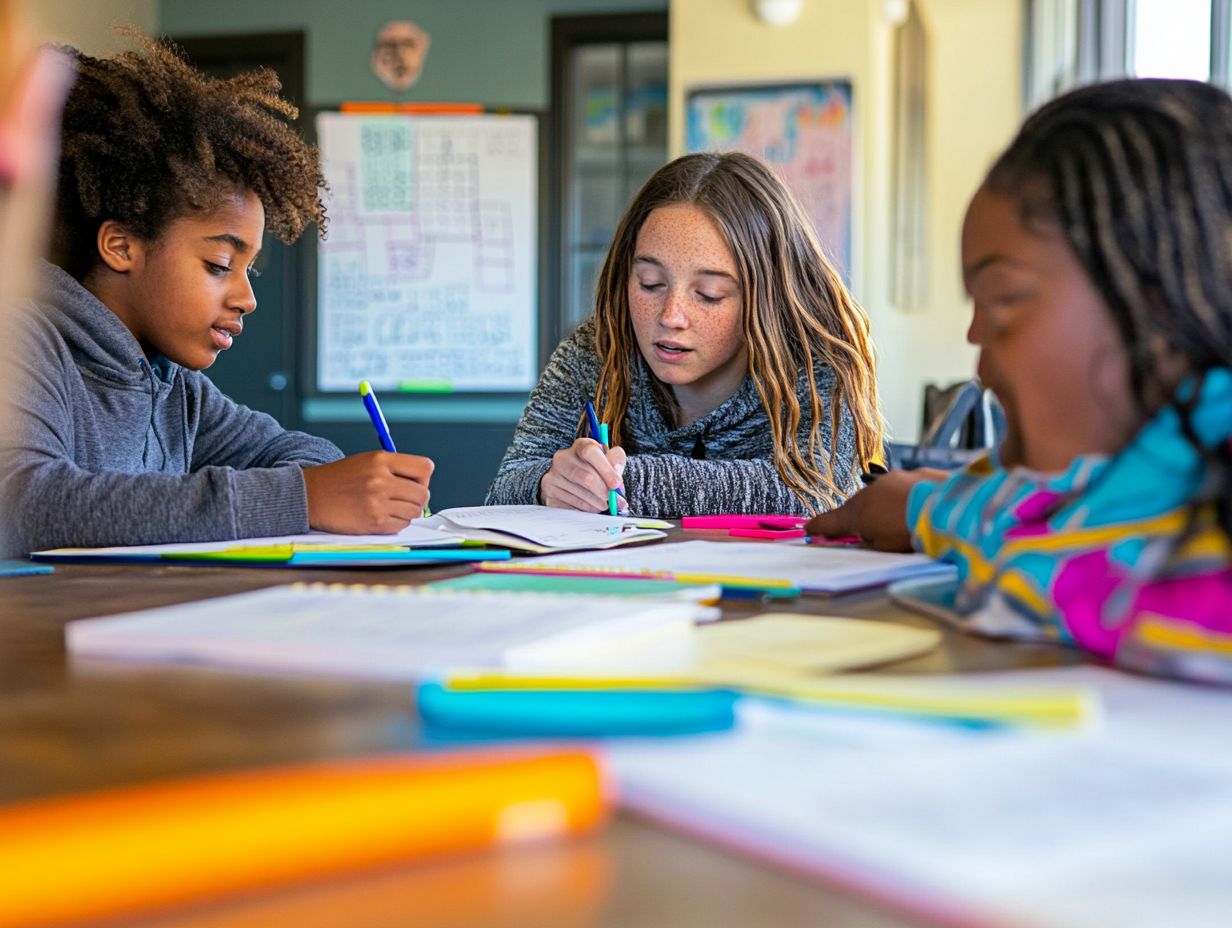
Utilizing creative writing exercises offers you a wealth of benefits in your ESL writing journey. You’ll find that these activities boost your vocabulary and enhance your writing confidence.
They also increase your engagement through interactive learning experiences. These exercises do more than just spark creativity; they enable you to express yourself.
By helping you articulate your thoughts and emotions with greater clarity, they refine your written expression. Dabble in various writing styles to discover new ways to share your unique perspective.
Practical activities like writing prompts or storytelling circles provide the perfect platform for weaving personal narratives. This fosters a deeper connection with the material.
Engaging in collaborative projects, such as reviews by classmates, allows you to refine your skills through constructive feedback. This further polishes your mastery of the language.
How Can Creative Writing Help Improve Language Skills?
Creative writing serves as a powerful tool for enhancing language skills among ESL students. It provides ample opportunities for writing practice, refining grammar, and cultivating fluency through engaging activities.
As you immerse yourself in the creative process, you’ll find your vocabulary expanding. This enables you to express ideas with greater vividness and accuracy.
For instance, using word prompts to inspire short stories encourages you to explore synonyms and antonyms. This effectively enriches your lexicon.
Participating in sentence-building exercises sharpens your syntax. You ll learn to structure your thoughts coherently.
Engaging in peer reviews enhances comprehension. You analyze each other’s work and discuss themes and narrative techniques.
These interactive methods not only spark creativity but also deepen your understanding of language in diverse contexts.
What Are Some Other Creative Writing Exercises for Language Learners?
Various creative writing exercises for language learners are invaluable for enhancing your ESL writing skills. They stimulate creativity and encourage critical thinking.
You can seamlessly integrate these exercises into your curriculum. They provide an opportunity to explore thoughts and feelings in a structured yet imaginative setting.
For example, storytelling prompts allow you to structure narratives while practicing essential grammatical elements. This makes the experience both enjoyable and educational.
Engaging in poetry writing helps you cultivate an appreciation for language. It invites you to play with words and delve into meaning.
Collaborative storytelling fosters teamwork and peer feedback. This enriches your learning journey.
By incorporating such diverse activities, educators can create a vibrant classroom atmosphere. This sharpens your writing abilities and nurtures confidence in expressing ideas.
Ultimately, this enhances your overall educational experience.
How Can Language Learners Incorporate Creative Writing into Their Study Routine?
Incorporating creative writing into your study routine can greatly enhance your language learning experience. This elevates your ESL writing skills and overall engagement with the language.
Start by dedicating just ten minutes a day to free writing. Allow your thoughts to flow freely without the constraints of grammar or spelling.
This is your time to let creativity take the lead. Utilizing writing prompts is another excellent way to ignite your inspiration.
There are countless apps and websites designed for creative writing that offer a variety of themes and character ideas to explore. Maintaining a journal is invaluable; it helps you track your progress and reflect on your learning journey.
Consider joining online writing communities where you can receive feedback and foster motivation from fellow writers. Experimenting with different genres be it poetry, short stories, or even flash fiction allows you to delve into the intricacies of language.
Ultimately, consistently weaving these activities into your routine can transform your study process into an enriching creative adventure. Start your creative writing journey today and discover all the benefits it has to offer!
What Are Some Tips for Overcoming Writer’s Block in Language Learning?
Overcoming writer’s block is a challenge you might face as a language learner. But with the right strategies, you can reignite your motivation for writing and engage in productive practice through creative techniques.
Some effective strategies include brainstorming exercises that are truly effective for sparking new ideas. Allow yourself to jot down any thoughts that come to mind, free from the constraints of structure or correctness just let it flow.
Free writing prompts offer a structured yet flexible way for you to delve into themes or questions that personally resonate with you. Engaging in writing with friends can significantly enhance your experience, as sharing your thoughts with others allows you to develop your narratives together. This collaborative environment fosters support and camaraderie, helping to ease the isolation that often accompanies writer’s block.
Frequently Asked Questions
What are some examples of creative writing exercises for language learners?

- Sentence Shuffle: Rearrange a sentence in a different order and have students rewrite it in the correct form.
- Story Starters: Give students a sentence or phrase to start a story and have them continue writing on their own.
- Picture Prompts: Show students a picture and ask them to write a story based on what they see.
- Dialogue Practice: Provide a conversation between two characters and have students write the dialogue.
- Alternative Endings: Have students rewrite the ending of a well-known story in their own words.
- Poetry Writing: Encourage students to write a poem using a specific form or structure.
- Word Association: Give students a random word and ask them to write a story or poem using that word.
- Journaling: Ask students to write a journal entry about their day or a specific event.
- Character Creation: Have students create a character and write a story or description about them.
- Rewriting a Story: Give students a short story and ask them to rewrite it with a different setting or time period.
How can these exercises help language learners improve their writing skills?
Get ready to supercharge your writing skills with these fun, creative exercises! They help students practice grammar, sentence structure, vocabulary, and creativity. By varying the types of exercises, students can develop different writing styles and techniques. These exercises also help build confidence in writing and encourage students to express themselves freely in the language.
Can these exercises be adapted for different levels of language learners?
Yes, these exercises can be adapted for different levels of language learners. For beginners, the exercises can focus on simple sentence structure and vocabulary. As students progress, the exercises can become more complex, including more advanced grammar and vocabulary. They are also suitable for different ages, making them appropriate for both children and adults.
How often should these exercises be used in language learning?
These exercises can be used as frequently as desired, depending on the goals of the language learning program. They can serve as warm-up activities at the beginning of a class or as more structured writing assignments. They are also a fun way to incorporate writing into language learning.
Do these exercises only focus on writing or can they also help with other language skills?
While these exercises primarily focus on writing skills, they can also help with other language skills. Through vocabulary and grammar practice, they can improve students’ reading and comprehension abilities. Additionally, the creative aspect of these activities helps students develop their speaking and listening skills as they share and discuss their writing with others.
Are there any resources or materials needed to implement these exercises?
Most of these exercises can be done with just pen and paper, but there are various online resources and materials that can enhance the experience. For example, using images or prompts from the internet or utilizing online writing tools for activities such as sentence shuffling. However, these materials are not necessary for the exercises to be effective in improving language skills.
